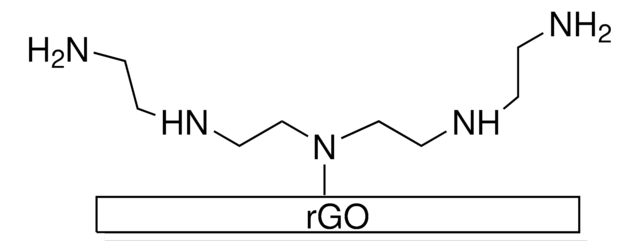Recommended Products
description
chemically reduced
form
powder
composition
Carbon, ≥75 wt. %
Nitrogen, >5 wt. %
Oxygen, <22 wt. %
surface area
450 m2/g
conductivity
>600 S/m
solubility
water: insoluble
Looking for similar products? Visit Product Comparison Guide
General description
The structure of graphene oxide is similar to graphene containing residual oxygen, heteroatoms and structural defects. Reduced graphene oxide (rGO) can be extracted as thin film from an aqueous solution of graphite oxide (GO) slurry. Many modern procedures for the synthesis of GO are based on the Hummers method, in which graphite is oxidized by a solution of potassium permanganate in sulfuric acid. Reduction of GO using hydrazine has been reported. However, hydrazine is highly toxic and can potentially functionalize GO with nitrogen heteroatoms. Because of these issues, alternatives to hydrazine including NaBH4, ascorbic acid, and HI, among others have been used for the reduction of GO. GO can be reduced as a thin film or in an aqueous solution. Reduction methods have been recently reviewed.
Application
The spin-coated reduced graphene oxide (rGO) thin films have been used as annode buffer layer to fabricate bulk heterojunction org. solar cells. PEGylated rGO may be used as:
- chemical sensors, biosensors
- as transparent electrodes in light emitting diodes (LEDs) and ITOs
- in lithium ion batteries.
Preparation Note
- Reduction method: Chemically reduced
- Color: Black
- Odor: Odorless
- Solubility: Insoluble
- Dispersability: It can be dispersed at low concentrations (<0.1mg/mL) in NPM, DMSO, DMF
- Electrical conductivity: > 600S/m
- BET surface area: 450 m2/g
Storage Class Code
11 - Combustible Solids
WGK
WGK 3
Flash Point(F)
Not applicable
Flash Point(C)
Not applicable
Certificates of Analysis (COA)
Search for Certificates of Analysis (COA) by entering the products Lot/Batch Number. Lot and Batch Numbers can be found on a product’s label following the words ‘Lot’ or ‘Batch’.
Already Own This Product?
Find documentation for the products that you have recently purchased in the Document Library.
Goki Eda et al.
Nature nanotechnology, 3(5), 270-274 (2008-07-26)
The integration of novel materials such as single-walled carbon nanotubes and nanowires into devices has been challenging, but developments in transfer printing and solution-based methods now allow these materials to be incorporated into large-area electronics. Similar efforts are now being
Somayeh Mousavi Nodoushan et al.
Biosensors & bioelectronics, 127, 221-228 (2019-01-10)
Detection of staphylococcal enterotoxin B (SEB) as a bacterial toxin causing severe food poisoning is of great importance. Herein, we developed an electrochemical aptasensor for SEB detection using a screen printed electrode modified with reduced graphene oxide (rGO) and gold
Zhang; Liming;
Journal of Material Chemistry B: Materials for Biology and Medicine, 1(6), 749-755 (2013)
Monique C P Mendonça et al.
Nanomaterials (Basel, Switzerland), 9(6) (2019-06-15)
Graphene-based nanomaterials (GBNs) possess unique physicochemical properties, allowing a wide range of applications in physical, chemical, and biomedical fields. Although GBNs are broadly used, information about their adverse effects on ecosystem health, especially in the terrestrial environment, is limited. Therefore
Rosa Garriga et al.
Nanomaterials (Basel, Switzerland), 10(8) (2020-08-23)
Carbon nanomaterials have attracted increasing attention in biomedicine recently to be used as drug nanocarriers suitable for medical treatments, due to their large surface area, high cellular internalization and preferential tumor accumulation, that enable these nanomaterials to transport chemotherapeutic agents
Our team of scientists has experience in all areas of research including Life Science, Material Science, Chemical Synthesis, Chromatography, Analytical and many others.
Contact Technical Service





